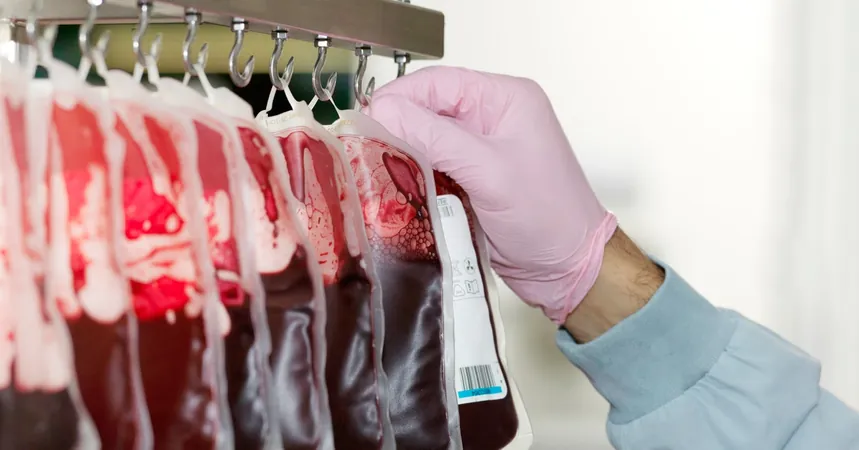
Groundbreaking Discovery: Scientists Unveil the 47th Blood Group System After a 50-Year Hunt!
2024-09-16
Introduction
In a remarkable culmination of years of research, scientists have finally cracked a 50-year-old mystery surrounding a peculiar blood group, unveiling the 47th blood group system known as AnWj. The story begins back in 1972 when a pregnant woman's blood sample raised a red flag for medical professionals due to the absence of a crucial surface marker, or antigen, that is typically present in red blood cells. This absence prompted concerns that have lingered in the medical community for decades, as mismatched blood transfusions can be fatal.
Early Investigations
Fast forward to the early 2000s: Louise Tilley, a dedicated researcher at NHS Blood and Transplant, picked up the thread of this enigma. With the rare emergence of other cases featuring the same missing antigen, Tilley and her team initially believed they would swiftly unravel the mystery. However, the reality was far more complex than anticipated, leading to nearly 20 more years of investigation.
The Breakthrough Study
The team’s persistence finally paid off, culminating in a comprehensive study published in the journal *Blood* that confirms the genetic basis behind AnWj-negative blood. With this discovery, it becomes evident that each individual's blood is classified within a total of 47 known blood group systems, including the well-known ABO and Rh systems. The recently identified AnWj system speaks to an infrequent variation, with the majority of individuals being AnWj-positive and only a minuscule number estimated to be AnWj-negative.
Understanding AnWj Negative Blood
The crucial antigen in question has been dubbed AnWj, named in reference to two individuals known to lack it. Research co-author Nicole Thornton believes the number of people with AnWj-negative blood could be fewer than a few tens of thousands globally. For these rare individuals, being aware of their blood type is potentially lifesaving, especially in transfusion situations where compatibility is essential.
Genetic Findings
The scientific journey involved pinpointing the genetic cause behind this blood group anomaly. While other studies posed alternative hypotheses, the Tilley team held strong in their belief that a gene known as MAL was central to the AnWj phenotype. Their eventual genetic sequencing revealed that AnWj-negative individuals exhibited a particular mutation in the MAL gene, leading to the absence of the AnWj antigen. This discovery also highlighted an interesting aspect: some individuals suffering from certain cancers may develop a transient form of AnWj-negative blood, affecting the expression of the MAL gene.
Significance of the Research
The success of this study not only validates years of dedication but establishes a clear pathway to identify potential donors for AnWj-negative patients. It’s a triumph for Tilley and her colleagues, who conducted meticulous experiments to confirm their findings, including innovative techniques that demonstrated the role of the MAL gene in red blood cell variation.
Expert Reactions
Experts have hailed this groundbreaking research as a landmark paper in the field of hematology. Sara Trompeter, a consultant hematologist at University College London, described the work as resembling a suspenseful detective show, where every tiny clue counts—a sentiment shared by Mark Vickers from the University of Aberdeen, who praised the study as a comprehensive endeavor into a complex subject.
Unanswered Questions
Despite the excitement surrounding the AnWj discovery, some unanswered questions remain. For instance, the development of the AnWj antigen does not occur in infants until they reach around seven days of age, a phenomenon that warrants further investigation.
Continued Research
What’s more, Tilley and her team had previously identified the genetic underpinnings of the Er blood group system just last year, adding to a growing list of new blood group systems that researchers have been discovering at an impressive rate over the past decade.
Future Prospects
With the promise of more breakthroughs on the horizon, Thornton teased, “We’ve got some more in the pipeline,” suggesting that the world of blood research holds even more secrets yet to be uncovered. As scientists continue to explore intriguing blood samples associated with unpredictable reactions, they are not only advancing medical understanding but also providing hope to patients in need of matching blood donors.
Conclusion
Reflecting on the long journey and the culmination of their work, Tilley expressed a profound sense of relief now that this pivotal paper has been published. “It’s a huge relief,” she stated, encapsulating the dedication and perseverance that led to this significant scientific achievement.


 Brasil (PT)
Brasil (PT)
 Canada (EN)
Canada (EN)
 Chile (ES)
Chile (ES)
 España (ES)
España (ES)
 France (FR)
France (FR)
 Hong Kong (EN)
Hong Kong (EN)
 Italia (IT)
Italia (IT)
 日本 (JA)
日本 (JA)
 Magyarország (HU)
Magyarország (HU)
 Norge (NO)
Norge (NO)
 Polska (PL)
Polska (PL)
 Schweiz (DE)
Schweiz (DE)
 Singapore (EN)
Singapore (EN)
 Sverige (SV)
Sverige (SV)
 Suomi (FI)
Suomi (FI)
 Türkiye (TR)
Türkiye (TR)